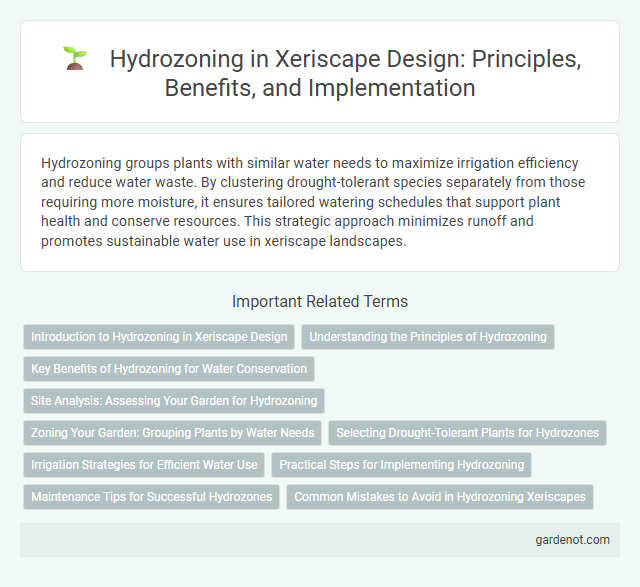Hydrozoning groups plants with similar water needs to maximize irrigation efficiency and reduce water waste. By clustering drought-tolerant species separately from those requiring more moisture, it ensures tailored watering schedules that support plant health and conserve resources. This strategic approach minimizes runoff and promotes sustainable water use in xeriscape landscapes.
Introduction to Hydrozoning in Xeriscape Design
Hydrozoning in xeriscape design involves grouping plants with similar water needs to optimize irrigation efficiency and conserve water resources. This strategy reduces water waste by applying tailored watering schedules and amounts based on specific plant requirements within each zone. Proper hydrozoning supports sustainable landscaping by promoting healthy plant growth while minimizing environmental impact.
Understanding the Principles of Hydrozoning
Hydrozoning is a landscape design strategy that groups plants with similar water needs together to maximize irrigation efficiency and minimize water waste. Understanding the principles of hydrozoning involves analyzing plant water requirements, soil type, and microclimates to create distinct irrigation zones. This approach reduces water consumption, promotes healthier plant growth, and supports sustainable xeriscape practices.
Key Benefits of Hydrozoning for Water Conservation
Hydrozoning organizes plants based on their water requirements, significantly reducing water waste by ensuring irrigation is tailored to specific zones. This targeted watering method enhances water use efficiency, promoting healthier plant growth while conserving valuable water resources. Xeriscape gardens implementing hydrozoning typically achieve up to 30-50% water savings compared to conventional landscaping practices.
Site Analysis: Assessing Your Garden for Hydrozoning
Site analysis for hydrozoning involves evaluating soil type, sun exposure, and existing vegetation to determine water needs for different garden zones. Understanding microclimates and topography helps group plants with similar irrigation requirements, optimizing water efficiency. Proper hydrozoning reduces water waste and supports sustainable xeriscape landscaping practices.
Zoning Your Garden: Grouping Plants by Water Needs
Hydrozoning in xeriscaping maximizes water efficiency by grouping plants according to their specific water requirements, reducing overwatering and runoff. Plants with similar hydration needs are clustered together, enabling targeted irrigation and enhancing the garden's overall sustainability. This strategic plant placement promotes healthier growth and conserves water resources in arid environments.
Selecting Drought-Tolerant Plants for Hydrozones
Selecting drought-tolerant plants for hydrozones maximizes water efficiency by grouping species based on their water needs. Plants such as succulents, native grasses, and Mediterranean herbs thrive with minimal irrigation, reducing overall consumption. Proper hydrozoning enhances soil moisture retention and promotes sustainable landscaping in xeriscape designs.
Irrigation Strategies for Efficient Water Use
Hydrozoning in xeriscape involves grouping plants with similar water requirements to optimize irrigation strategies for efficient water use. By separating high-water-demand plants from drought-tolerant species, irrigation systems can be precisely tailored, reducing water waste and promoting healthier plant growth. Utilizing drip irrigation and smart controllers further enhances efficiency by delivering water directly to plant roots based on real-time moisture data.
Practical Steps for Implementing Hydrozoning
Hydrozoning involves grouping plants with similar water requirements to maximize irrigation efficiency and conserve water in xeriscaping. Practical steps include conducting a soil and plant water needs assessment to categorize zones accurately, installing separate irrigation lines for each zone, and using moisture sensors to adjust watering schedules based on real-time soil moisture levels. Regular monitoring and maintenance ensure that each zone receives appropriate water amounts, reducing waste and promoting plant health.
Maintenance Tips for Successful Hydrozones
Effective maintenance of hydrozones involves regular monitoring of soil moisture to prevent overwatering and ensure plant health. Pruning and mulching native drought-tolerant plants reduce water loss and promote deep root growth. Adjusting irrigation schedules seasonally optimizes water use efficiency, matching the specific water needs of each hydrozone.
Common Mistakes to Avoid in Hydrozoning Xeriscapes
Common mistakes in hydrozoning xeriscapes include improper grouping of plants with differing water needs, leading to inefficient irrigation and plant stress. Overlooking soil types and microclimate variations causes uneven moisture distribution, reducing water conservation benefits. Failing to regularly assess and adjust zones based on plant maturity and seasonal changes results in water waste and compromised landscape health.
Hydrozoning section Infographic

 gardenot.com
gardenot.com